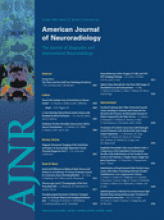Abstract
BACKGROUND AND PURPOSE: Numerous different parameters measured by perfusion MR imaging can be used for characterizing gliomas. Parameters derived from 3 different analyses were correlated with histopathologically confirmed grade in gliomas to determine which parameters best predict tumor grade.
METHODS: Seventy-four patients with gliomas underwent dynamic susceptibility contrast-enhanced MR imaging (DSC MR imaging). Data were analyzed by 3 different algorithms. Analysis 1 estimated relative cerebral blood volume (rCBV) by using a single compartment model. Analysis 2 estimated fractional plasma volume (Vp) and vascular transfer constant (Ktrans) by using a 2-compartment pharmacokinetic model. Analysis 3 estimated absolute cerebral blood flow (CBF), cerebral blood volume (CBV), and mean transit time (MTT) by using a single compartment model and an automated arterial input function. The Mann-Whitney U test was used make pairwise comparisons. Binary logistic regression was used to assess whether rCBV, Vp, Ktrans, CBV, CBF, and MTT can discriminate high- from low-grade tumors.
RESULTS: rCBV was the best discriminator of tumor grade ype, followed by CBF, CBV, and Ktrans. Spearman rank correlation factors were the following: rCBV = 0.812 (P < .0001), CBF = 0.677 (P < .0001), CBV = 0.604 (P < .0001), Ktrans = 0.457 (P < .0001), Vp = 0.301 (P =.009), and MTT = 0.089 (P = .448). rCBV was the best single predictor, and Ktrans with rCBV was the best set of predictors of high-grade glioma.
CONCLUSION: rCBV, CBF, CBV Ktrans, and Vp measurements correlated well with histopathologic grade. rCBV was the best predictor of glioma grade, and the combination of rCBV with Ktrans was the best set of metrics to predict glioma grade.
- Copyright © American Society of Neuroradiology












